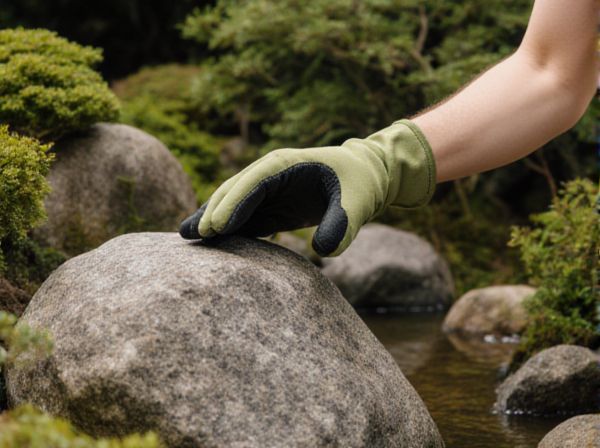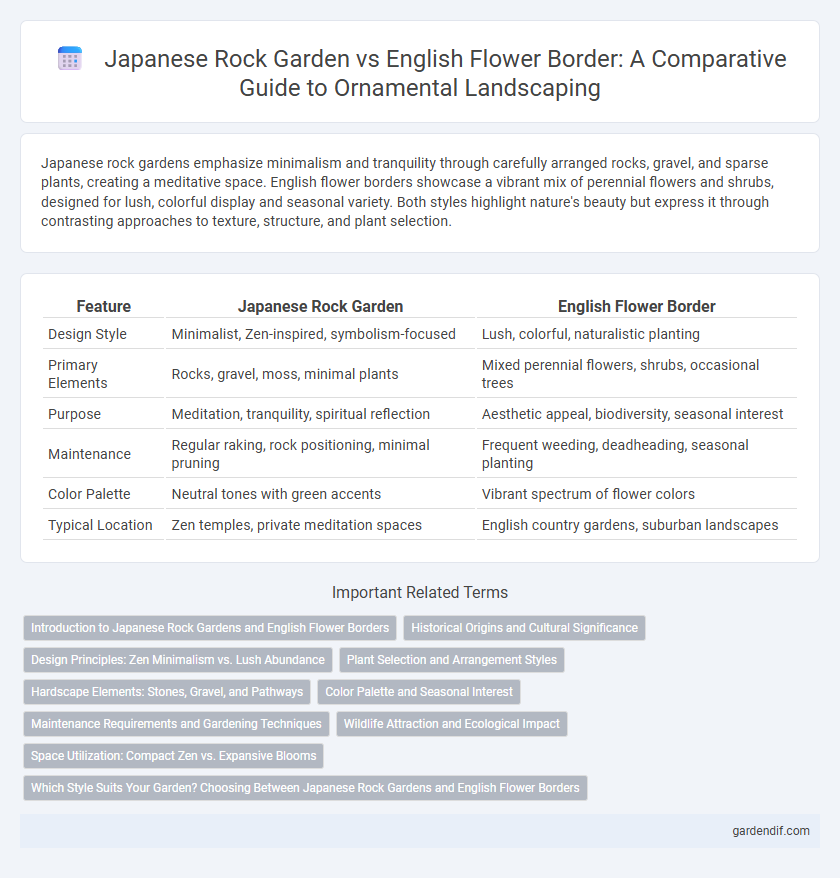
Japanese rock garden vs English flower border Illustration
Japanese rock gardens emphasize minimalism and tranquility through carefully arranged rocks, gravel, and sparse plants, creating a meditative space. English flower borders showcase a vibrant mix of perennial flowers and shrubs, designed for lush, colorful display and seasonal variety. Both styles highlight nature's beauty but express it through contrasting approaches to texture, structure, and plant selection.
Table of Comparison
| Feature | Japanese Rock Garden | English Flower Border |
|---|---|---|
| Design Style | Minimalist, Zen-inspired, symbolism-focused | Lush, colorful, naturalistic planting |
| Primary Elements | Rocks, gravel, moss, minimal plants | Mixed perennial flowers, shrubs, occasional trees |
| Purpose | Meditation, tranquility, spiritual reflection | Aesthetic appeal, biodiversity, seasonal interest |
| Maintenance | Regular raking, rock positioning, minimal pruning | Frequent weeding, deadheading, seasonal planting |
| Color Palette | Neutral tones with green accents | Vibrant spectrum of flower colors |
| Typical Location | Zen temples, private meditation spaces | English country gardens, suburban landscapes |
Introduction to Japanese Rock Gardens and English Flower Borders
Japanese rock gardens emphasize minimalism, using carefully arranged rocks, gravel, and moss to symbolize natural landscapes and promote meditation. English flower borders showcase vibrant, densely planted perennial and annual blooms, designed for visual abundance and seasonal variation in traditional garden settings. Both styles reflect distinct cultural aesthetics, with Japanese gardens highlighting simplicity and tranquility, while English borders prioritize color diversity and ornamental richness.
Historical Origins and Cultural Significance
Japanese rock gardens, rooted in Zen Buddhist traditions since the Muromachi period (14th-16th centuries), symbolize serenity and meditation through minimalist arrangements of rocks, sand, and moss, reflecting principles of simplicity and nature's essence. English flower borders emerged in the 19th century Victorian era, showcasing diverse, colorful plant varieties arranged to demonstrate horticultural knowledge and aesthetic pleasure, reflecting a celebration of natural beauty and botanical exploration. Both garden styles serve as cultural expressions: the Japanese rock garden emphasizes spiritual contemplation, while the English flower border highlights ornamental exuberance and personal creativity.
Design Principles: Zen Minimalism vs. Lush Abundance
Japanese rock gardens emphasize Zen minimalism by using simple arrangements of rocks, gravel, and sparse plantings to create a tranquil, meditative space. In contrast, English flower borders showcase lush abundance through dense, colorful layers of diverse flowering plants arranged in a structured yet naturalistic manner. These design principles reflect cultural values: serene simplicity in Japanese gardens versus vibrant richness in English garden traditions.
Plant Selection and Arrangement Styles
Japanese rock gardens prioritize minimalistic plant selection, featuring mosses, evergreens, and carefully pruned shrubs to emphasize simplicity and Zen aesthetics. English flower borders showcase a diverse array of perennials, annuals, and shrubs arranged in dense, colorful layers designed to create vibrant, naturalistic displays. The contrasting plant arrangements reflect Japanese gardens' emphasis on tranquility and space versus English borders' maximalist, blooming abundance.
Hardscape Elements: Stones, Gravel, and Pathways
Japanese rock gardens emphasize minimalistic hardscape elements with carefully placed stones and raked gravel that symbolize natural landscapes and promote tranquility. English flower borders incorporate hardscape components like curved stone pathways and edging to complement dense plantings, enhancing structural contrast and garden fluidity. The Japanese style prioritizes simplicity and symbolic meaning in hardscape, while the English border focuses on integration and ornamental detail within its pathway and stonework.
Color Palette and Seasonal Interest
Japanese rock gardens emphasize muted, natural tones like grays, blacks, and greens, creating a minimalist color palette that highlights texture and form rather than vibrant hues. In contrast, English flower borders showcase a diverse and vivid color palette, featuring rich reds, purples, yellows, and blues to provide dynamic seasonal interest throughout spring, summer, and autumn. The Japanese rock garden's evergreen plantings and rocks offer year-round visual stability, while the English flower border evolves with blooming cycles, offering constantly changing color and floral diversity.
Maintenance Requirements and Gardening Techniques
Japanese rock gardens demand minimal maintenance through careful raking patterns and occasional pruning of moss or bonsai, emphasizing simplicity and meditation. English flower borders require frequent weeding, deadheading, and seasonal planting to maintain their vibrant, layered floral displays and diverse plant varieties. Both garden styles benefit from understanding specific plant needs, but Japanese rock gardens focus more on structural aesthetics, while English borders prioritize continuous floral renewal.
Wildlife Attraction and Ecological Impact
Japanese rock gardens emphasize minimalism and stone arrangements, creating habitats that attract small insects and promote biodiversity through mosses and lichens. English flower borders support a diverse range of pollinators such as bees, butterflies, and birds by planting a variety of flowering species that offer nectar and shelter. Ecologically, English flower borders contribute more significantly to local wildlife support and ecosystem health compared to the more symbolic and less vegetative Japanese rock gardens.
Space Utilization: Compact Zen vs. Expansive Blooms
Japanese rock gardens maximize space through minimalist arrangements of stones, gravel, and moss to create a compact, tranquil environment that emphasizes simplicity and meditation. In contrast, English flower borders utilize expansive linear layouts filled with diverse, colorful blooms to create vibrant, layered visual impact that celebrates abundance and seasonal change. The Japanese rock garden's compact design fosters introspection in limited space, while the English flower border transforms larger areas into dynamic, flowering displays.
Which Style Suits Your Garden? Choosing Between Japanese Rock Gardens and English Flower Borders
Japanese rock gardens emphasize minimalist design, using carefully placed rocks, gravel, and moss to create a tranquil, meditative space suited for small or Zen-inspired gardens. English flower borders showcase vibrant, dense planting with a variety of perennials and shrubs, ideal for gardens that prioritize colorful blooms and seasonal interest. Your garden's size, climate, and desired ambiance will determine whether the serene simplicity of a Japanese rock garden or the lush diversity of an English flower border best complements your outdoor space.
Japanese rock garden vs English flower border Infographic

 gardendif.com
gardendif.com